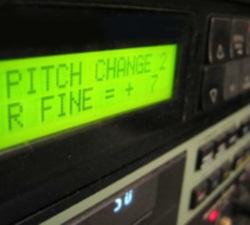
The power of these effects is in how they are mixed with the original sound. So we need some way to control that blend. In most cases, you’ll connect the effects device so that it is fed from a post-fade auxiliary send on your console. The output of the effects device comes back into the console at the auxiliary return input, or on a spare channel.
In this application, you want to set the mix knob on the unit all the way to the wet position. This ensures that only the effect is being heard at the aux return. You’ll establish your dry-to-wet ratio by adjusting the aux send knob on each channel.
If these effects devices were only being used with consoles in the manner I’ve just described, there would be no need for the mix knob. But a guitar player, for example, might want to use it just with his rig. With the mix knob in the dry position, he’ll hear only the direct sound from his guitar.
With the knob in the wet position, he’ll hear only the effect. The mix knob allows him to control the balance between those two sounds to achieve the blend he’s looking for. The only way you will ever become adept at using these devices is to read the operator’s manual—y’know, that book that’s still in the box somewhere—and then experiment.
Now, I’m guilty too—I often operate by the motto “when all else fails, read the directions.: So learn from my shortcomings and do what I teach. The time to experiment is first on your own, then during rehearsals. Then apply what you’ve learned in a deliberate, creative effort during a service, maybe during the midweek service first, to get used to it.
The unspoken caution here is don’t experiment with the effects during a service, at least not until you are very comfortable with the device and know what you are doing with it. Even then, approach its use with care. One good way to force yourself to learn the unit is working with a singer and accompaniment tapes.
Whenever I’m in this situation, I listen to what the original track is doing with regard to the lead vocalist’s effects. Then I listen to the accompaniment track by itself to see what delays and reverb sounds are still there.
And finally, during rehearsal I’ll try to enhance the singer’s voice very much like the original recording did. With those effects happening, and with the track loud enough over the system to be realistic, the end result is quite believable.
One more comment regarding the use of these effects. When the song is over, be certain that the aux returns receiving the signal from the delays and reverb are off before the pastor or anyone, including the vocalists, begins to speak. It’s terribly embarrassing to hear a long, repeating delay of the pastor’s voice thanking the vocalists for their musical offering. (Of course, that’s never happened to me…)
Don’t be afraid to use effects in your service. Tastefully applied, they can bring new depth and dimension to the sound of your music.
And most importantly, have fun!
Summary of Acoustic Effects
* Reverberation – many repetitions, becoming more densely spaced with time.
* Echo – one or a few discrete repetitions of an audio signal.
* Delay – the time interval between a direct signal and its echo.
* Decay – the time it takes for echoes or reverberation to fade away. And we can summarize the different techniques available for simulating these techniques this way:
* Echo Chamber – In effect an acoustic means of creating an artificial reverb by setting speakers in a large room and picking up the resulting sound with microphones.
* Plate Reverb – constructed of a large sheet of metal or foil which is suspended from its corners. It has a small speaker mounted on the sheet, which makes it vibrate, after which two widely spaced contact microphones pickup the resulting vibrations. In its day, this was the brightest-sounding and most popular type.
* Spring Reverb – A cost-effective unit. Less expensive types are often characterized by a twangy sound when driven too hard.
* Analog Effects Devices – Electronic devices which use an analog bucket-brigade circuitry to provide signal delays and reverb sounds.
* Digital Effects Processors – Because of their flexibility, variety of sounds, and control over individual parameters, digital effects processors have replaced the majority of other reverb types. Kudos to the engineers and DSP software engineers who have developed and written the algorithms that make these units so spectacular.
Curt Taipale of Taipale Media Systems heads up Church Soundcheck.com, a thriving community dedicated to helping technical worship personnel, as well as the Church Sound Boot Camp series of educational classes held regularly throughout the U.S.
